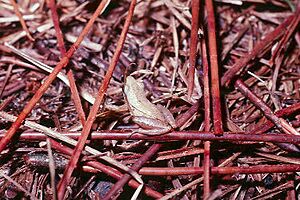Little grass frog facts for kids
Quick facts for kids Little grass frog |
|
|---|---|
 |
|
| Conservation status | |
| Scientific classification | |
| Synonyms | |
|
The little grass frog (Pseudacris ocularis) is a tiny frog that lives only in the Southeastern United States. It is the smallest frog in all of North America! You can find these little jumpers in many different wet places, like ponds and marshes that might dry up sometimes.
Contents
Description of the Little Grass Frog
The little grass frog is the smallest frog in North America. It only grows to about 19 millimeters (or 0.75 inches) long. That's smaller than your thumbnail!
These frogs are usually light brown. But sometimes, they can have a hint of green or pink color. A cool thing about them is the dark stripe that goes through each of their eyes. This stripe runs all the way down the sides of their body.
The word ocularis in their scientific name comes from Latin. It means "of the eye." This name was chosen because of that bold stripe near their eyes.
Where Little Grass Frogs Live and What They Eat
Little grass frogs live in many wet places in the southeastern United States. These places include wetlands that might dry up sometimes, and others that stay wet longer. They especially like grassy spots near cypress ponds and similar areas.
These frogs are a good sign of a healthy wetland. If you don't see them in city wetlands, it might mean the area isn't as healthy. They often hang out on lower tree trunks and leaves, sometimes a meter or more high. Male frogs like to call from these spots.
Even though they perch high, they spend a lot of time looking for food on the ground. Little grass frogs can turn their heads and necks more than other frogs. This is because their backbone is extra flexible. This helps them look for food or find a good spot to jump from.
They mostly eat tiny bugs found in leaf litter and soil. These include springtails, ants, and thrips. Some research has shown that adult frogs also eat larger insects like roaches and walking sticks, and even mites.
Reproduction and Life Cycle
To get a female's attention, male little grass frogs sit on grass stems or tree trunks and call out. Their calls sound like high-pitched insect chirps.
These frogs breed in shallow wetlands that don't have fish. This includes places like cypress domes, marshes, and wet forests. They usually breed from January to September in most areas. But in Florida, they can breed all year long!
Female frogs can lay eggs more than once a year. They lay up to 200 eggs, usually in small groups of 1 to 5 eggs. The eggs are laid on the bottom of a pond or on plants in shallow water.
The eggs hatch in just 1 to 2 days. The tiny tadpoles (larvae) then take about 7 to 70 days to change into little frogs. This process is called metamorphosis.
Little Grass Frog Behavior
The call of the little grass frog is special. It has two parts: a clear tone followed by a series of quick chirps. This type of call is unique among frogs in their family (Hylidae).
Little grass frogs are often active both during the day and at night. In some parts of their home range, they can be active all year long.
How Little Grass Frogs Avoid Predators
The little grass frog has a few ways to stay safe from animals that want to eat them. Even though they are small, they can jump about 20 times their own body length! This amazing jump helps them escape quickly.
Their colors also help them hide. They have "cryptic coloration," which means their skin color blends in with the plants around them. This makes it hard for predators to see them. The dark stripes through their eyes and along their sides also help break up their body shape. This makes them even harder to spot.
Some common predators of adult little grass frogs are fish, larger frogs, and snakes. For the young tadpoles, dragonfly nymphs are known to hunt them.


